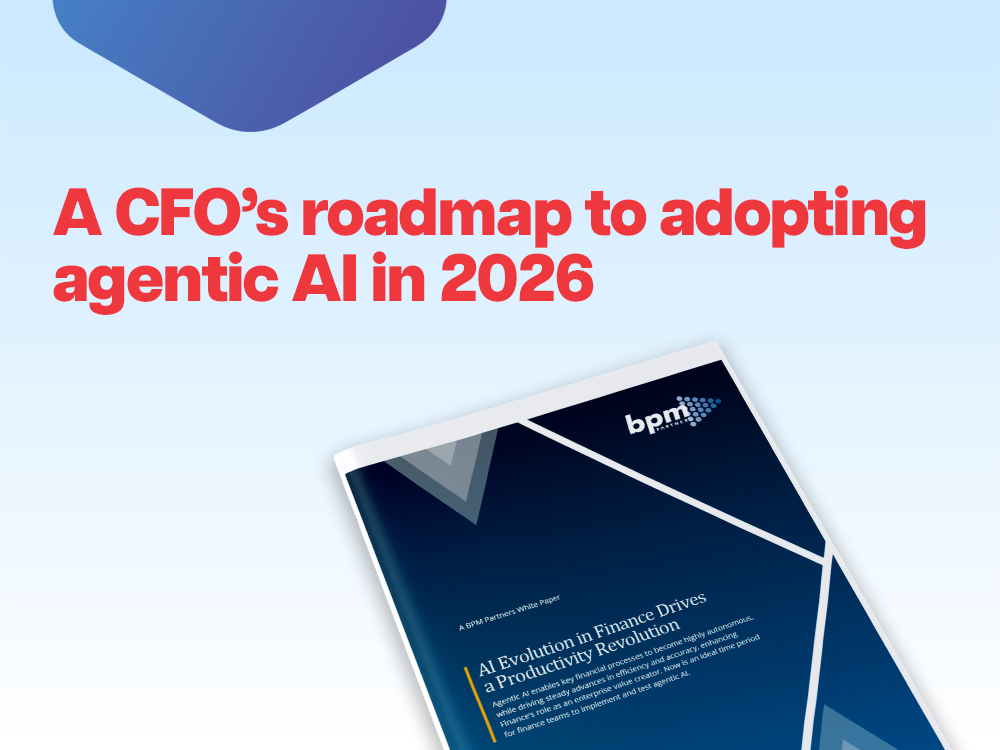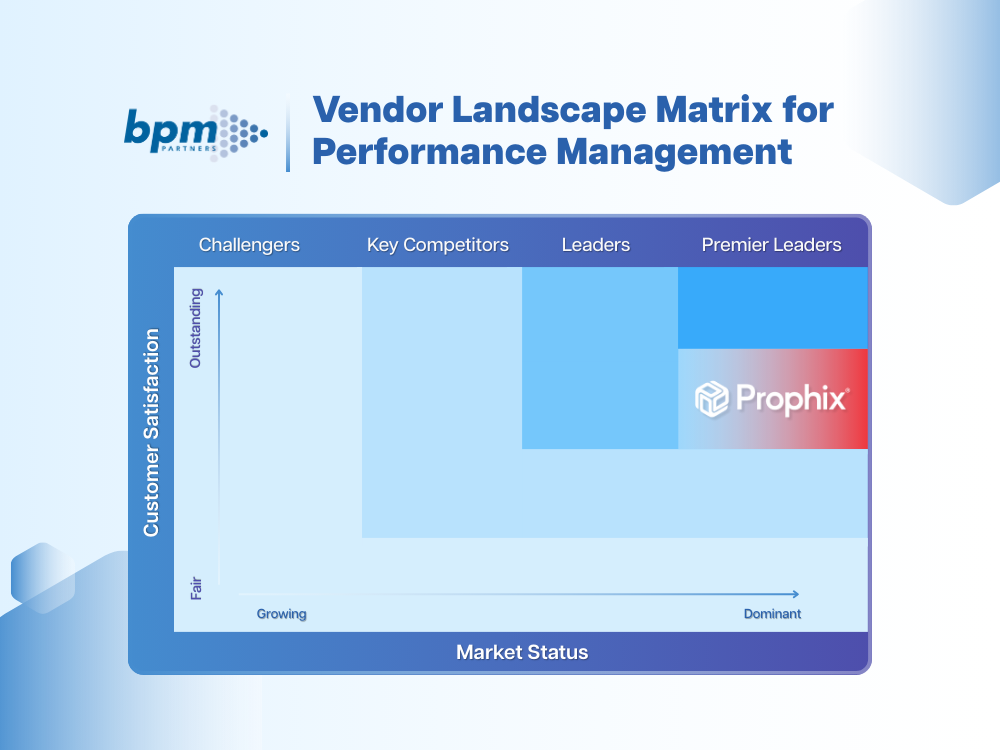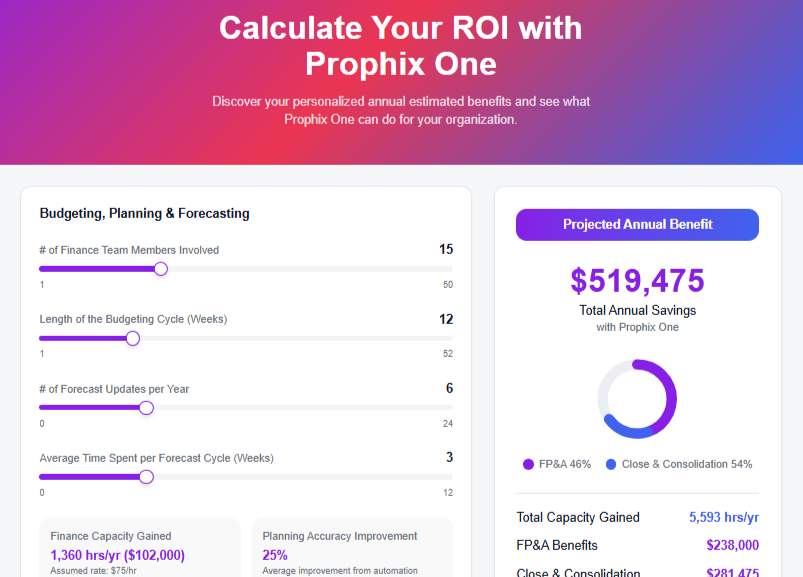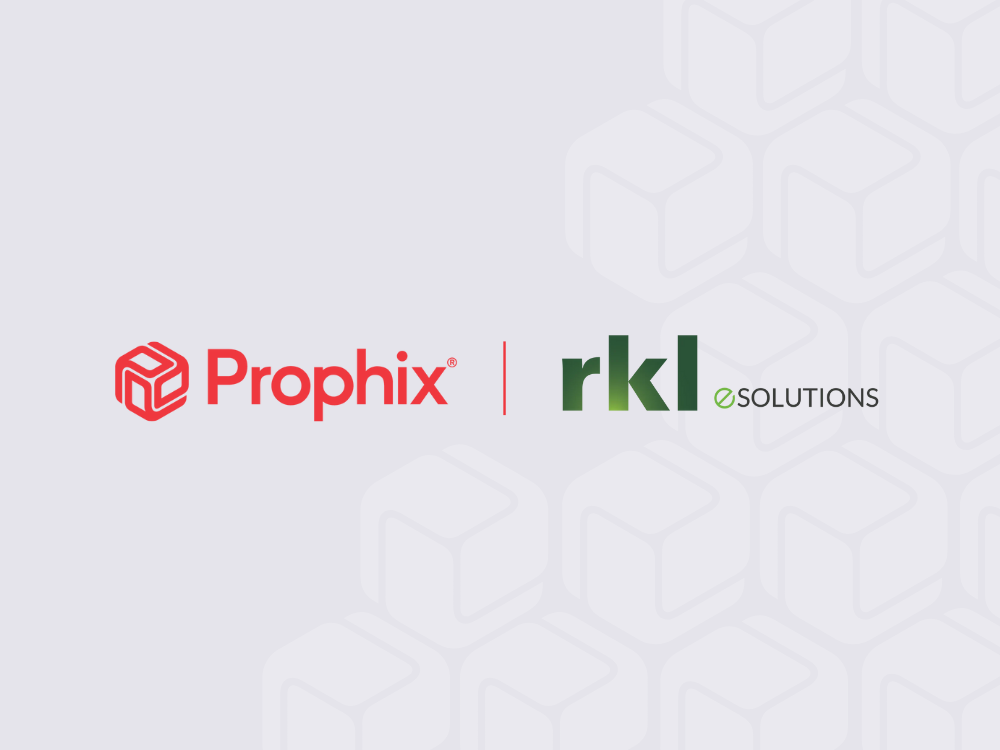Download Analyst Report
Prophix One versus Cube Software: a side-by-side comparison
Choosing between Prophix and Cube? Learn how both FP&A tools support forecasting, scenario planning, and finance automation—tailored for growing teams.
September 9, 2025Mid-market finance teams now use around 24 FP&A tools. That’s part of why CFOs call financial decision-making their biggest challenge. Prophix One, a Financial Performance Platform, and Cube Software each take a different approach to solving it.
Budgeting, forecasting, and reporting are standard in both. What sets them apart is how they help teams actually get the work done. Here’s a closer look at how Prophix One and Cube compare, what they offer, how they differ, and when to choose one over the other.
Similarities between Prophix One and Cube Software
Prophix One and Cube Software are both cloud-based financial planning platforms designed to help teams move beyond manual spreadsheets. They cover core functions like budgeting, forecasting, reporting, and analytics. While they take different approaches, they share a lot of common ground, so let’s start with where they overlap.
Budgeting
Both Prophix One and Cube Software support structured budgeting workflows. You can create department-level budgets, track different versions, and manage approvals without the need for extra back-and-forth.
Planning
Both tools let teams model different scenarios and adjust plans as things shift. Rolling forecasts make it easier to stay aligned with changing business goals.
Forecasting
The best financial forecasting software updates automatically as your data changes. Prophix One and Cube do this well, but in different ways. They help teams react quickly to shifts in revenue, rising costs, or changes in staffing needs.
Financial reporting
Reporting is a strong point for both. Prophix One’s FP&A software offers more customization, while Cube makes it easy to build reports inside a familiar spreadsheet environment.
Data Integration
Both tools integrate with widely used systems like NetSuite, QuickBooks, and Microsoft Dynamics, helping finance teams work with real-time, reliable data. Prophix One handles more complex imports. Cube Software upgrades your spreadsheets without replacing them.
Analytics
Each platform helps turn data into insights in its own way. Prophix One focuses on built-in data validation and consolidation. Cube, on the other hand, keeps things simple with clean, easy-to-read dashboards that highlight key metrics at a glance. While they differ in complexity, both count among today’s top financial analytics tools, especially for teams looking to move beyond static spreadsheets.
Collaboration
Each tool supports team-based workflows. You can assign roles, manage access, and collaborate in real time, without compromising accuracy or control.
What users say
Where both Prophix One and Cube Software earn high marks from users:
- Easy integration with ERP and business systems
- Reliable reporting and analytics tools
- Scalability for growing teams
- Responsive customer support
- Clear visibility into key financial data
- Less time spent on manual, spreadsheet-heavy tasks
Both tools deliver results, but they serve different purposes. Each packs unique features built for how teams actually work.
Unique features of Prophix One vs. Cube software
While Prophix One and Cube offer many of the same core features, they take different approaches. The key difference lies in how each platform delivers those features.
What Prophix One brings to the table
Prophix One is designed for finance teams that manage more complexity. If you’re planning across multiple departments, scenarios, or timeframes, Prophix One brings everything into one structured platform. It’s built to scale, making it a good fit for companies that are in high-growth mode.
Where it pulls ahead:
- Creates multi-scenario rolling forecasts that update with real-time data
- Uses Prophix One Intelligence to explain trends and variances with AI-driven insights
- Automates reviews, approvals, and reminders through built-in workflows
- Supports key parts of the close process, including financial consolidation, intercompany management and account reconciliation
- Supports pre- and post-close processes like cash and lease management, management reporting, disclosure management and global tax compliance
- Offers real-time dashboards that track KPIs by team, region, or product
- Centralizes reporting and validation to reduce errors and cleanup work
- Delivers more reliable forecasts and ensures group-wide accuracy because models are fed with consolidated data
- Uses the latest cloud native tech like in-memory processing, automated scaling, multi threading and other optimizations which deliver unmatched speed and performance
Prophix One removes the need for back-and-forth spreadsheet updates, all while giving leaders more control and visibility.
What makes Cube different
Cube Software is built for speed and simplicity. It’s a great choice for FP&A teams that already use Excel or Google Sheets and don’t want to change their workflow.
Here’s what it does well:
- Integrates directly with spreadsheets so you can keep using familiar tools
- Gets up and running fast, often in days, without needing consultants
- Offers flexible data mapping with tags, alternate hierarchies, and business logic
- Automates cleanup tasks like currency conversion and sign flipping
- Tracks user changes and inputs to maintain accuracy across the team
- Delivers reporting views that are easy to build, share, and update
Instead of replacing spreadsheets, Cube improves them with automation and better data control.
Prophix One vs Cube software: Which solution is right for you?
Both solutions work well, but the best choice depends on what you need most. There are a few things to consider before making the call.
Think about your company size and structure
If you’re a mid-sized to enterprise company with multiple departments, entities or growing complexity, Prophix One is probably the better fit. It gives finance teams the structure, control, and flexibility to make planning work at scale. It’s built for teams that need a platform that can grow with them.
If you’re part of a leaner team at a startup or fast-moving business, Cube Software can help you stay quick on your feet. It’s easy to roll out and works inside Excel or Google Sheets, though it may feel limited as your planning gets more complex.
Consider your internal tech setup
Prophix One fits well in organizations with multiple systems and a need for broad integration. It centralizes planning, reporting and close across tools like your ERP, CRM, and HRIS.
Cube works well if you’re already managing your planning in spreadsheets and want to clean it up without switching platforms. It connects your source systems but keeps the spreadsheet interface.
Look at how much time you have to implement
Prophix One takes more time up front, but that time goes into building a structure that pays off over the long term. Cube can be up and running in days. It works well for leaner teams, though it may not offer the same long-term depth.
Think about how your team collaborates
Prophix One supports structured workflows with assigned tasks, version control, and built-in reminders that keep planning on track. It’s built for teams that need accountability and clear oversight across departments.
Cube, on the other hand, offers real-time collaboration in tools like Excel and Google Sheets. It’s a lighter lift, but if your process lacks structure, it may not take you much further.
And don’t forget user preferences
Many teams choose Cube because it feels familiar. But more are turning to Prophix One when they need structure, automation, and room to grow.
When you weigh all these factors, it helps to see how Prophix One and Cube Software stack up side by side. The table below breaks down the key differences to guide your decision.
Feature
Prophix One
Cube Software
Best for
Mid-market and enterprise teams ready to scale and streamline
Small teams working mostly in spreadsheets
Setup time
Takes more time up front, but sets you up with structure that scales
Quick to launch, minimal lift
Interface
Dashboard-driven and built for financial control and visibility
Feels like Excel—familiar and simple
Core strengths
Automation, budgeting and planning, forecasting, consolidation and close in one platform
Speed, flexibility, and spreadsheet comfort
Automation
Strong automation that cuts down manual work and errors
Covers basic rules and updates
Collaboration
Structured workflows with tasks, approvals, and version control
Real-time edits in Sheets or Excel
Reporting
Detailed reports, templates, and audit-friendly tracking
Clean, easy-to-read dashboards
Scenario planning
Built for deeper, more precise, multi-scenario, multi-year forecasting
Quick what-if models
Integrations
Connects across ERP, CRM, HRIS, and more for full planning alignment
Works best with simple setups
Ease of use
Simple to use once set up, with helpful workflows and prompts
Very easy for spreadsheet users
Pricing
Higher investment—but you get enterprise-grade tools and ROI
Lower monthly cost
Limitations
Takes longer to set up, but pays off with long-term control
Can hit limits with scale and complexity
Customer support
Dedicated onboarding and long-term support from FP&A experts
Fast and responsive
If you’re after something quick and familiar, Cube does the job. But if you’re serious about scaling your planning, Prophix One is the smarter move.
Final thoughts: Choose finance software that scales with your business
Both Prophix One and Cube Software give finance teams room to breathe and plan ahead. That’s why they’re some of the best business budgeting software for CFOs.
Teams have been able to cut planning cycles from two months to two weeks with Prophix One. Others reduced monthly processes by 75% and saved over $20,000 a year. Forecasts that once took days now run overnight. Teams wake up to updated reports, ready to go.
However, the right choice ultimately depends on how your team works and where you want to go next. If Prophix One sounds like the right fit, request a demo and see how it can simplify planning from day one.
Ready to see what you can do with Prophix One?





